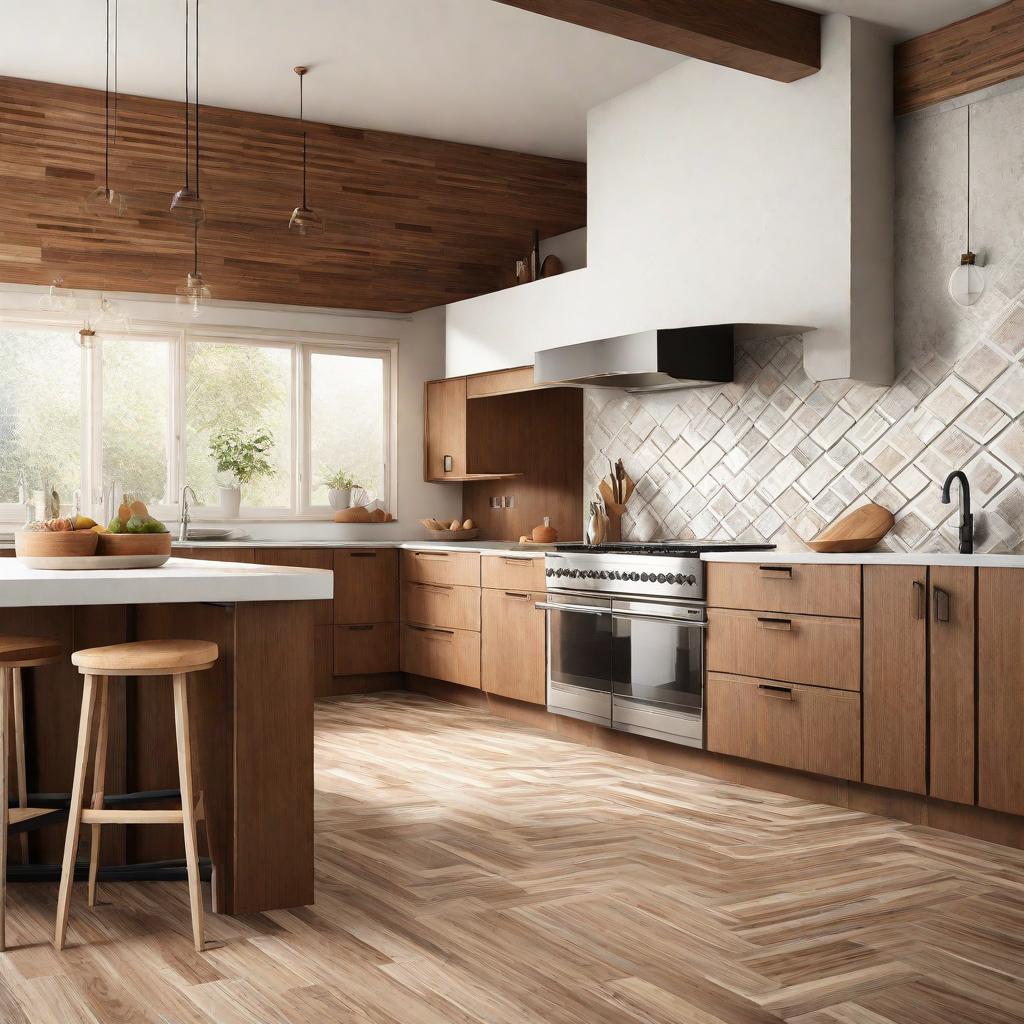Are you tired of the harsh and abrupt transition between your kitchen tile and wood flooring? Well, you’re not alone. Many homeowners struggle with finding the perfect way to merge these two popular flooring options seamlessly. Luckily, there are plenty of floor transition ideas to help you achieve a cohesive and stylish look in your kitchen floor. In this blog post, we’ll explore some creative wood floor transition ideas that will transform your kitchen into a stunning space. Say goodbye to uneven edges and hello to a smooth and stylish transition between your tile and wood floors. Let’s get started!
Why the Right Floor Transition Matters
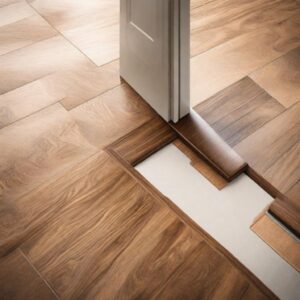
Selecting the ideal floor transition for your kitchen isn’t just about the visual effect; it plays a pivotal role in creating a harmonious and unified interior design. It’s the linchpin that seamlessly fuses two different flooring types, creating an elegant and cohesive living space. Not only can it uplift the visual charm of your kitchen, but it can also offer practical benefits. For instance, a well-executed floor transition can mitigate safety risks by minimizing the chance of stumbling over uneven surfaces. Therefore, it’s essential to pick the right floor transition that marries aesthetics with functionality. From the classic T-bar to the artistic mosaic, each option offers a unique set of characteristics that can enhance your kitchen’s ambiance while ensuring a smooth and safe passage.
T-Bar Transitions: A Classic Choice
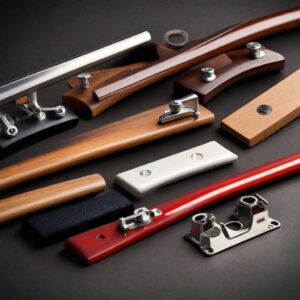
T-bar transitions stand as an enduring favorite in the world of floor transitions. True to its namesake, this T-shaped connector is the go-to choice for bridging the gap between tile and wood flooring that are on the same level. The magic of T-bars lies in their versatility. They are not confined to a particular material or finish, instead, they offer an array of choices to match your kitchen’s decor. Their sleek design adds a touch of understated elegance to your kitchen, subtly demarcating the different flooring types. T-bars offer a clean, unobtrusive junction that ensures the transition from tile to wood is as smooth as your Sunday morning coffee. This makes them not only a timeless classic but a safe and practical solution too. Choose a T-bar transition if you’re after a solution that effortlessly marries form and function.
Transition Strips: Versatility at Its Best
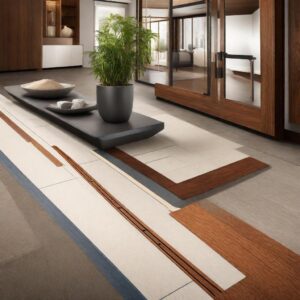
If your kitchen features wood and tile floors of varying heights, transition strips may just be your saving grace. These functional accessories come in an array of designs, from flat to curved, each bringing its own unique charm. Crafted from different materials and boasting numerous finishes, transition strips allow you the freedom to match your existing decor seamlessly. But they offer more than just an aesthetic upgrade. Transition strips serve a practical role in ensuring a gradual shift from one floor type to another, diminishing the risk of unfortunate missteps and accidents. Whether it’s a contemporary kitchen with a mix of ceramic tile and oak or a rustic setup with terracotta and reclaimed wood, transition strips flex their adaptability muscles by complementing diverse styles and floor levels. It’s this blend of beauty and versatility that makes transition strips a go-to option for kitchen floor transitions. Their capacity to merge functionality with style can help elevate your kitchen’s design while ensuring your safety.
The ‘Border’ Transition: Highlighting the Divide
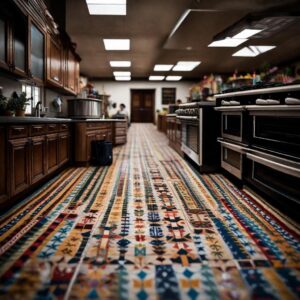
The ‘border’ transition is an ideal choice for homeowners seeking a clear demarcation between their kitchen’s tile and wood flooring. This style of transition sets a distinctive boundary, clearly separating the two types of flooring. However, this need not mean a harsh or jarring contrast. On the contrary, borders can be tailored to your specific design preferences, offering a myriad of options in terms of material and design complexity.
From a minimalist, straight line to intricate geometric patterns, a border transition allows you to make a style statement while effectively bridging the divide between your kitchen’s different floor materials. This type of transition introduces a sophisticated element to your kitchen, adding depth and visual intrigue to your floor.
Whether you opt for a border that matches your tile, complements your wood, or even introduces a third material for an unexpected twist, the ‘border’ transition offers ample room for creativity. This way, your kitchen flooring transition is not just a functional necessity, but an integral part of your interior design narrative.
However, while the aesthetics are paramount, do not overlook the practical aspects. It’s crucial that the border transition doesn’t pose a tripping hazard or interrupt the smooth flow of foot traffic. So, as you plan your kitchen floor makeover, remember to marry your design aspirations with functional considerations, ensuring your ‘border’ transition enhances your kitchen both visually and pragmatically.
The ‘Curve’ Transition: Blending with Elegance

Imagine stepping into your kitchen, and your eyes gently follow the graceful curve that marries your tile and wood flooring. This is the allure of the ‘curve’ transition, an elegant solution that smoothly intertwines two distinct floor materials into a harmonious unity. Rather than a harsh, linear divide, the curve transition softly guides one flooring type into another, producing a pleasing, organic flow that soothes the eye.
The charm of this style is its ability to soften the visual interruption between different flooring materials. By eliminating sharp edges and boundaries, a curve transition can create an illusion of a larger and more inviting space. It’s the architectural equivalent of a gentle, rolling hill, merging two landscapes without a hint of discord.
Yet, it’s not just about aesthetics. The curve transition, by its very nature, eliminates any abrupt level changes, reducing the risk of tripping. So, this elegant solution not only makes your kitchen more appealing but also contributes to the safety and comfort of the space.
A curve transition can be particularly effective in a kitchen with a contemporary design. Its sleek and organic appearance is the perfect complement to the clean lines and minimalistic vibe of modern interiors. Yet, it’s also versatile enough to suit more traditional or eclectic styles, adding a touch of sophistication and uniqueness.
Whether your kitchen design leans towards the modern or the classic, the ‘curve’ transition brings an element of elegance that effortlessly blends the diverging characteristics of tile and wood flooring. It’s a testament to the power of subtle design elements in shaping our experience of a space, making the transition between two floor types not just necessary, but a delightful design feature in itself.
Mosaic Transition: Artistic Flair
For those who enjoy expressing their unique personality and creativity through home design, a mosaic transition is a perfect choice. This style of floor transition involves weaving an intricate pattern that forms a bridge from your tile to your wood flooring. This process is like painting a picture, where your tile and wood are the canvas, and the pieces of mosaic are your colors and brush strokes.
This approach transforms your kitchen floor into a work of art, capturing the attention and admiration of anyone who steps foot into your kitchen. The stunning mosaic pattern doesn’t merely serve as a transition but becomes a focal point, adding an extra layer of interest and sophistication to your kitchen’s design.
However, creating a mosaic transition is no small task. It requires meticulous planning, precision, and a keen eye for detail. Each piece of the mosaic needs to be thoughtfully chosen and perfectly placed to create a beautiful, seamless transition from the tile to the wood. But, when done correctly, the result is a striking design element that adds a wow factor to your kitchen.
Remember, the design of your mosaic transition should complement the style and color scheme of your kitchen. From a modern abstract pattern to a traditional geometric design, the possibilities are virtually limitless. So, let your creativity soar, and use this opportunity to put your unique stamp on your kitchen.
While the primary purpose of a mosaic transition is to add visual appeal, it’s also important to ensure it’s practical and safe. A well-executed mosaic transition should offer a smooth, even surface to prevent any tripping hazards. So, balance your artistic aspirations with functional considerations when planning your mosaic transition. With careful planning and execution, a mosaic transition can transform your kitchen from ordinary to extraordinary.
Kitchen Floor Design Considerations for Transitions
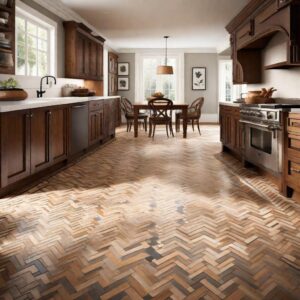
Making the right decision on your kitchen floor transition starts with having a deep understanding of your kitchen’s overall aesthetics. Are you leaning towards a contemporary, sleek vibe? Or, perhaps, you’re charmed by the warmth of a rustic, traditional setting? With a modern kitchen, a clean T-bar or strip transition may enhance its minimalistic allure, harmoniously blending with the sophisticated ambiance. On the flip side, for a classic or rustic kitchen, a border or intricate mosaic transition could inject an extra dash of character, enhancing its timeless appeal.
However, beyond visual delight, you also have to account for practicality and safety. It’s crucial to ascertain that your chosen transition does not obstruct smooth movement, posing a tripping hazard. In essence, your transition should offer not just an appealing sight to the eyes, but a safe and easy passage underfoot. Therefore, when planning your kitchen floor transition, ensure that beauty and functionality go hand in hand, creating a space that’s as enjoyable to navigate as it is to admire.
Conclusion
Incorporating the right floor transition can truly transform the look and feel of your kitchen.
Whether you’re transitioning from tile to wood, it’s essential to consider the aesthetic appeal, as well as functionality.
From contrasting colors to subtle gradients, there are numerous ideas to experiment with to achieve the desired effect.
By seamlessly blending textures, colors, and materials, you can create a space that exudes elegance and sophistication.
So, why settle for a mundane transition when you can take your kitchen floor to the next level?
Embrace creativity, explore different options, and give your kitchen a makeover that will leave everyone in awe.


